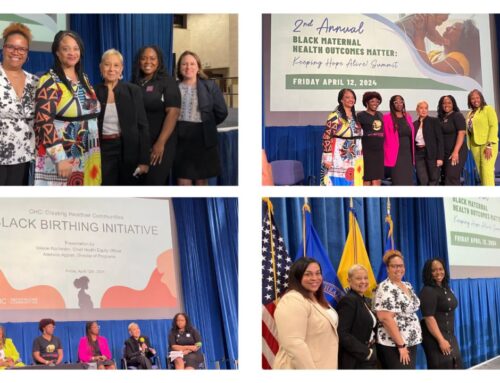The “Hidden Curriculum” and the health of Black women – What is being done?
A long-standing lack of diversity in research design and medical illustrations may be contributing to health inequities for Black women, but communities are taking notice and taking action. In recognition of Black Maternal Health Week, we’re highlighting this issue and other issues that affect Black maternal health.
Alarming news in maternal health suggests that the crisis is worsening for Black women. The maternal death rate for Black mothers is still much higher than for other women. Black women are 50% more likely to deliver a premature baby. And a recent study found a striking disparity in infant health – Black babies die at almost three times the rate of White infants from sudden unexpected deaths.
Disparities cannot simply be explained by education or socioeconomic levels. Communities must continue to address social determinants of health – an issue that CHC strives to address through our Black Birthing Initiative. Additionally, implicit bias, sometimes reinforced through medical training, can affect health outcomes. The lack of diversity in research design and medical illustrations is a long-standing issue with implications for Black mothers and, consequently, Black families.
Diversity in Medicine
Research has shown that more diversity in healthcare providers can lead to better outcomes for Black Americans. One study found that Black men treated by Black doctors during wellness screenings were more likely to seek preventative healthcare. Black doctors and other minorities are also more likely than White counterparts to work in underserved communities. Similarly, Black researchers are more likely to propose research related to Black communities and Black health – research needed to better address social determinants of health that affect communities. However, medical education resources (both the formal curriculum and the informal messages that are communicated in training) must continue to change towards better serving Black women and birthing people.
The “Hidden Curriculum”
Researchers are looking more closely than ever at the “hidden curriculum” – the unwritten, social and implied lessons that can influence values and perspectives in education. While formal curriculum may emphasize treating all patients equally, underrepresentation of racial minorities in textbooks, training and case studies may be undermining that message. A lack of inclusion in research and medical illustration compounds the issue in Black maternal health.
As recently as 1977, a Food and Drug Administration (FDA) policy recommended excluding all women of childbearing age from clinical trials. Nearly 10 years later, the National Institutes of Health (NIH) released a policy reversing this stance. However, racial and sex disparities persist today. These disparities translate into real-world implications in death, quality of live and economics. A recent FDA analysis found that fewer than 20% of drug trials had data regarding treatment benefits or side effects reported for Black patients.
Visualizing the Patient
Medical students do not gain first clinical experience until the third of fourth year of medical school. In the classroom, medical textbooks continue to miss the mark on diversity. One study found that less than 5% of the images in textbooks used at top medical school showed dark skin. From plastic surgery to emergency medicine, medical illustrations skew towards overrepresenting White men in comparison to the actual representation in the US population. A lack of representation can lead to misdiagnosis, inappropriate treatment, and poorer health outcomes. Similarly, excluding Black women from medical texts can contribute to the erasure of Black women’s experiences and needs in the healthcare system.
A viral tweet created by Nigerian medical student resonated with many on social media who noted that they had never seen a Black fetus represented in medical illustration. Black pregnant women have experienced this disparity for decades in waiting rooms and medical offices across the US.
Working Towards Inclusion
Researchers, government agencies, associations and crowd-sourced communities have taken some steps towards equity. Though more work remains, the FDA has developed some tools to encourage diversity in clinical trial representation. The NIH, recognizing that people may experience the same disease differently, has included goals in the NIH Minority Health & Health Disparities Strategic Plan 2021-2025 to address clinical trial disparities.
Further, the Association of Medical Illustrators created #AMIdiversity, an initiative in 2021 to highlight and promote diversity awareness. Community groups have also stepped in to meet critical needs in maternal health. In 2022, an online community for women launched the Reframing Revolution, a royalty-free digital gallery of images that reflect broad diversity of women and women’s bodies.
Representation matters in health equity. By continuing to work towards greater representation of Black women in research, medical illustrations and other tools used in medical education, we can improve health outcomes and build trust between patients and providers.

I'm black and black is beautiful!
— Chidiebere Ibe (@ebereillustrate) November 24, 2021
Diversity in Medical Illustration
More of this should be encouraged!
Illustration by @ebereillustrate#pregnant #MedEd #scicomm #inclusion #AcademicTwitter #MedTwitter #illustration #Metaverse
Please support this cause🙏 https://t.co/Tye9WT1hud pic.twitter.com/YGrzINJfoe







